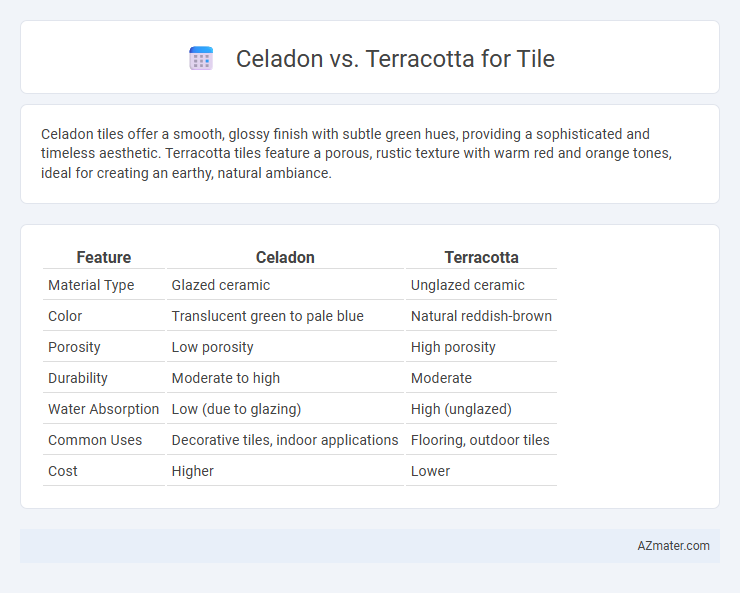Celadon tiles offer a smooth, glossy finish with subtle green hues, providing a sophisticated and timeless aesthetic. Terracotta tiles feature a porous, rustic texture with warm red and orange tones, ideal for creating an earthy, natural ambiance.
Table of Comparison
| Feature | Celadon | Terracotta |
|---|---|---|
| Material Type | Glazed ceramic | Unglazed ceramic |
| Color | Translucent green to pale blue | Natural reddish-brown |
| Porosity | Low porosity | High porosity |
| Durability | Moderate to high | Moderate |
| Water Absorption | Low (due to glazing) | High (unglazed) |
| Common Uses | Decorative tiles, indoor applications | Flooring, outdoor tiles |
| Cost | Higher | Lower |
Introduction to Celadon and Terracotta Tiles
Celadon tiles, known for their translucent jade-green glaze, offer a smooth, glossy surface that enhances interior aesthetics with a timeless, elegant appeal. Terracotta tiles provide a warm, rustic charm through their porous, earthy red clay composition, celebrated for durability and natural texture. Both tile types serve distinct architectural and design purposes, combining functionality with unique visual styles in flooring and wall applications.
Origins and Historical Significance
Celadon originated in ancient China during the Eastern Han Dynasty and became highly prized for its jade-like glaze and subtle green hues symbolizing purity and status. Terracotta, one of the oldest ceramic materials, dates back to prehistoric times across various cultures, notably in the Mediterranean and South Asia, valued for its earthy tones and durability in construction and art. Both materials reflect their cultural heritage, with celadon embodying refined craftsmanship and terracotta representing utilitarian and decorative versatility throughout history.
Material Composition and Production
Celadon tiles are primarily made from high-quality porcelain clay that is fired at high temperatures to achieve a smooth, translucent glaze with a characteristic pale green to blue hue. Terracotta tiles are composed of natural, porous earthen clay that is fired at lower temperatures, resulting in a dense, reddish-brown, and rustic finish. The production of celadon involves a precise glazing process and higher kiln temperatures, whereas terracotta relies on minimal glazing and traditional sun or kiln firing methods, emphasizing raw texture and warmth.
Visual Appearance and Color Palette
Celadon tiles exhibit a translucent, glossy surface with variations of soft green and bluish hues, creating a serene and elegant aesthetic ideal for modern and traditional designs alike. Terracotta tiles offer a matte, rustic texture with warm shades of earthy reds, oranges, and browns, evoking a natural, Mediterranean or Southwestern ambiance. The color palette of celadon emphasizes cool, muted tones, while terracotta favors rich, warm, and organic colors, making each suitable for distinct visual atmospheres in architectural and interior applications.
Durability and Maintenance Requirements
Celadon tiles, crafted from high-fired porcelain, offer superior durability with excellent resistance to cracks and chips, making them ideal for high-traffic areas. Terracotta tiles are more porous and softer, requiring regular sealing to prevent moisture damage and stains, which increases maintenance efforts. Celadon's low porosity reduces upkeep, whereas terracotta demands consistent care to maintain its appearance and structural integrity.
Suitability for Indoor and Outdoor Spaces
Celadon tiles, known for their smooth glaze and subtle green-blue hues, offer a sophisticated and moisture-resistant option primarily suited for indoor spaces such as kitchens and bathrooms. Terracotta tiles, with their porous, earthy texture and warm reddish-brown tones, excel in outdoor settings, providing durability and natural slip resistance ideal for patios and garden paths. Both materials require appropriate sealing; celadon benefits from standard ceramic protection indoors, while terracotta demands more frequent sealing to withstand outdoor weather conditions effectively.
Cost Comparison and Budget Considerations
Celadon tiles typically have a higher price point than terracotta due to their glazed finish and intricate coloration processes, making them less budget-friendly for large-scale projects. Terracotta tiles, known for their natural, unglazed, and rustic appearance, offer a cost-effective option that fits well within tighter budgets. When comparing costs, consider the long-term durability and maintenance expenses, as terracotta may require sealing while celadon tiles often provide easier upkeep, influencing overall budget planning.
Design Versatility and Aesthetic Appeal
Celadon tiles offer a smooth, translucent glaze with subtle greenish-blue hues, making them ideal for creating serene, elegant spaces that complement both traditional and modern interiors. Terracotta tiles, characterized by their warm, earthy tones and natural texture, bring rustic charm and a handcrafted feel that enhances Mediterranean and Southwestern designs. Both materials provide distinct aesthetic appeal and design versatility, allowing for varied applications from flooring to wall accents depending on desired ambiance and style.
Environmental Impact and Sustainability
Celadon and terracotta tiles differ significantly in environmental impact and sustainability; celadon tiles, often glazed and fired at high temperatures, consume more energy during production compared to terracotta, which is typically low-fired and made from natural clay. Terracotta is biodegradable and often sourced locally, reducing carbon footprint associated with transportation, while celadon's glazing process may involve chemicals that challenge eco-friendliness. Choosing terracotta supports sustainable practices through minimal processing and renewable resource use, making it a preferred option for environmentally-conscious building projects.
Choosing Between Celadon and Terracotta Tiles
Choosing between celadon and terracotta tiles depends on the desired aesthetic and functional qualities of your space. Celadon tiles feature a smooth, glossy surface with a pale green glaze that offers a refined, elegant look ideal for modern or minimalist interiors. Terracotta tiles are porous, earthy, and rustic with warm reddish-brown tones, providing durability and natural charm suited for traditional or outdoor environments.

Infographic: Celadon vs Terracotta for Tile
 azmater.com
azmater.com